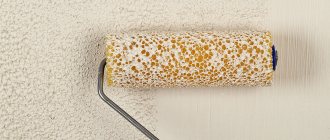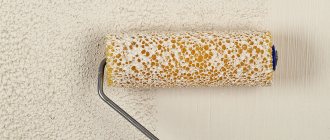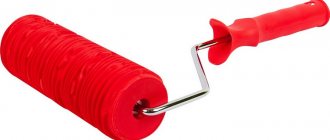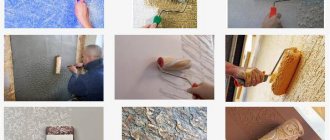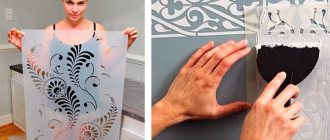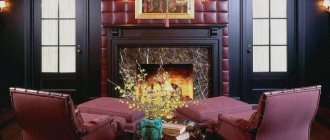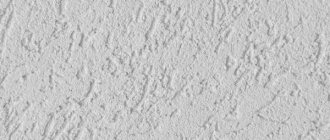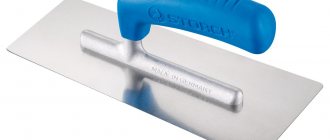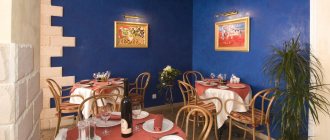Decorative roller is constantly used for finishing work using structural plaster. In addition, it can be improved or made with your own hands. A homemade roller is a budget option that can be used to qualitatively cover the walls yourself and to your taste.
Using a homemade roller you can create original wall decor
Textured and structural rollers for decorative plaster
Decorative plaster or paint has recently become particularly popular, as it allows you to give the room a stylish, original interior. And to work with these finishing materials, a textured roller is used. And what types of them exist and what their features are, we will now try to find out.
- Textured rollers and features of their use
- Materials for making decorative rollers
- Classification of decorative rollers by pattern texture
- How to make a decorative roller yourself First method
- Option number two
- Third way
- Fourth option
Textured rollers and features of their use
To work with a textured roller, you do not need any special skills or knowledge.
It is enough just to prepare the paint and roll the tool in a special ditch. This must be done in order to avoid smudges when painting the surface. And in this case the paint will lay down in an even layer. And the plaster is free of clots and lumps on the surface. Note! It is highly undesirable to use the same tool for different types of coatings. That is, for textured paint we use one type of tool, and for plaster, respectively, another. You can buy such tools in a store or make your own.
Materials for making decorative rollers
Modern instruments differ in the type of material they use. Today the following types of decorative rollers are available on the market:
- Rubber cover . On the base of the tool there are protrusions with depressions of various shapes and sizes, thanks to which a pattern or texture is created on the surface. For example, imitation of a relief plane with patterns, brickwork, etc. But such a tool is suitable only for experienced craftsmen, because it requires certain skills in operation.
- Wooden base. Such texture tools are best used for painting walls in children's rooms, since wood is considered an environmentally friendly material, and therefore does not emit harmful substances when used. It can also be used to create original convex patterns and ornaments on a painted surface. But there is one significant drawback - a wooden roller, unlike its rubber counterpart, can swell during operation. To avoid this, the instrument must be thoroughly cleaned and dried after each use.
- Leather base. With it you can give the surface a marble effect. An excellent choice would be a tool with a base made of genuine leather. If we are talking about applying Venetian plaster, then it will become an indispensable assistant.
- Plastic base . Not the best option. The thing is that with prolonged use, the plastic base can crack, thereby ruining the pattern on the surface of the walls. If you decide to use it, you must remember that textured plaster can only be applied on a perfectly smooth surface.
- Pile base. The roller cover is made of synthetic or natural fur with fibers of various lengths. When choosing this type of tool, you must remember that the longer the fibers, the rougher the surface will be and the more patterned the inclusions on the wall will be. It is recommended to give preference only to high-quality tools with reliable fastening of the fibers.
There are also analogues with a base made of foam rubber, polystyrene foam and fabric. Foam rubber options are used for priming the first layer for subsequent application of decor. They are also great for creating bubbles on the surface. Fabric analogues, for the manufacture of which plush soft fabric is used, form relief marks (patterns) on the wall. Devices with a foam base resemble a rubber counterpart. But you need to remember that polystyrene foam is short-lived.
Classification of decorative rollers by pattern texture
Each tool has a different structure that produces the final design. This can be an imitation of natural materials or arbitrary ornaments. All instruments are divided into two types.
Types of tools:
- Textured rollers . With their help, you can create an imitation of fur, wood, textiles and natural stone chips on the surface. To create the effect of uneven fibers, you can use a tool with a fur roller. And to imitate natural stone, use a roller with a pattern in the form of loops. It is recommended to use such a tool on a primed surface without preliminary finishing.
- Structural rollers for decorative plaster . With their help, you can apply a complex repeating pattern to the wall thanks to the curly cutout on the roller. The peculiarity of their use is that the coating must be applied to a prepared surface with finishing. For example, a painted or plastered wall without relief must be dried and then decorated. And in order to achieve the most beautiful pattern, processing must be carried out using a figured analogue with a certain pattern.
Also, the tools are divided among themselves according to the width of the roller. The minimum width reaches 30 centimeters. The wider the roller, the faster it is to apply textured paint. But a narrow roller allows you to create a clear, original structure.
How to make your own decorative roller
Some finishing tools are quite expensive. Therefore, making a roller with your own hands from scrap materials will be an excellent and inexpensive way out of this situation. And now you will find out how to do it.
How to choose rollers for applying decorative plaster
Now there are quite a large number of different methods for applying decorative coatings to a particular surface. This circumstance determines a very impressive selection of tools designed to perform these manipulations.
Quite often, when decorating walls, a type of tool such as a roller is used. This device is divided into two types:
- textured roller.
- structural roller.
Each of these types of tools has its own structural features, which determines the types of facing operations in which these devices are directly involved.
In addition, rollers are made from various materials. In accordance with this, the following models can be named:
Pattern application process
- foam;
- plastic;
- rubber;
- leather.
However, this list can be supplemented with homemade devices made from other raw materials. It all depends on the desire and imagination of the designer.
As for the texture of the tool itself, it should be noted that the roller is capable of quite high-quality imitation of the following building materials:
- marble;
- brick;
- tree;
- mat weaving.
Along with this, there is the possibility of using various attachments that help create all kinds of patterns.
The photos published below show different variations of the cladding, for the creation of which a special roller was used.
Textured roller
The device is shown in the photo.
In order for decorative plaster to acquire a specific relief, it is necessary to use a special tool during the cladding process, the surface of which corresponds to the desired finish texture. Consequently, protruding prints can be obtained on the wall being processed using a device that accurately displays the selected pattern.
In the case where the decorative plaster should have an embossed pattern, you should choose a roller whose working surface is equipped with a relief pattern.
Structural and textured plaster rollers - what are they?
For unusual wall decoration, designers increasingly prefer plaster, due to its distinctive qualities: environmental friendliness, durability, aesthetic appearance and enormous opportunities for realizing ideas. The most intricate textures are created using such a simple tool as a decorative roller.
Textured and structural rollers - what they are, features of their use
The device consists of a rotating cylinder on a curved handle with a variety of coatings that create artistic elements. The textured roller imprints a three-dimensional pattern on the newly applied plaster layer. For example, this way you can imitate brickwork or, using a variety with fur, create an aesthetic roughness. A structural roller is used to apply repeating decor with paint on a dry surface; working with this technique may seem more difficult due to the fact that you need to avoid smudges, but it is easy to learn. This technique is used to decorate wood and fabric.
Classification of decorative rollers by pattern texture
Rollers for decorative plaster can recreate almost any motif. Thus, they are used to imitate marble or other stone, brick, wood, textiles, and sand. The thicker the layer of plaster coating and the deeper the coil is pressed, the more voluminous the pattern is.
There are more tricky patterns:
- Waves;
- Braids;
- Shells;
- Ferns and dried flowers;
- Birch bark.
In addition to all kinds of forms presented in stores, the designer can develop a stencil to create an exclusive ornament on a single object, or even several.
Painting with a texture roller is like creating your own wallpaper design. Typically, floral or abstract themes are chosen, but, if desired, images of birds, waves, and leaf veins can be applied.
Also, tools come in different widths; the wider, the process goes faster there, but narrow ones allow you to repeat the pattern in stripes and provide a clear depiction of small details.
Materials for making decorative rollers
The production of rollers with patterns from all kinds of materials opens up enormous possibilities for flights of fancy. By type of stamps, almost everything is used. What varieties can be found in construction stores:
Conclusion
Using a roller not only speeds up and simplifies painting work, but also improves its quality. Today there are many varieties of this tool, and to understand how to choose or use one or another type, watch the video in this article and master our instructions.
What is this tool? Its design is quite simple. Depending on the type, the roller cylinder can be plastic, wood or metal. A variety of natural and synthetic materials are used as absorbent coatings. The cylinder is placed on a curved metal rod, which is attached to the handle.
Rollers are divided into several groups according to their purpose. The first, second and third groups are intended for working with paints and varnishes and have their own letter designations: VM - coated with fur; VMP – fur, for painting flooring; VMU - used for applying paint to concave corner surfaces. The last group - VP, coated with polyurethane foam, is used exclusively for working with water-based adhesive materials.
Making a textured roller from scrap materials
Using textured plaster, you can create a unique relief pattern on the walls and ceiling. For this, in addition to the material, you will need textured rollers. They can be made of different materials: foam rubber, rubber, plastic and so on. The easiest way is to purchase the product in a store, but you can make a textured roller with your own hands.
Based on an old tool
You will need a used but intact roller made of any material and any size. It is very important that the handle of the product is preserved. The remaining parts can be easily found in any home.
With a rope
To make a roller, you need to take a regular clothesline or any cord and wind it around the workpiece. The more often the cord is wound, the denser the pattern will be. You can use various winding methods, make intersections, and so on. The result is a relief pattern of depressions. Before using a homemade roller, it is recommended to test it on a small section of the wall or an unnecessary sheet of plywood.
Making a textured roller using rope
With a knife
If a foam roller remains in acceptable condition after finishing, then it can also be used. To do this, you need to take a stationery or sharply sharpened regular knife and cut out strips, squares or any other shapes of any size. The larger they are, the larger the texture of the drawing will be. You can process a foam roller in the same way. If there is an unnecessary new product made of foam rubber, then simply tighten it with thread so that wrinkles form.
Practice
For those who want to master the technique of working with their own hands, we have compiled instructions:
- The surface is cleaned of dust and debris and primed;
- We cover the boundaries of the work area with masking tape, cover the floor under the walls and furniture with newspapers or film;
- Pour the paint into a special tray according to the size of the roller. The tray should have a raised area for rolling out the roller and removing excess paint;
- Dip a long-haired tool into the paint, roll it over the mesh, then apply a thin, even layer. We work from top to bottom, making an overlap of several centimeters between adjacent strokes (stripes) so that the boundaries are not visible;
- After the first layer has dried, change the roller to medium pile and apply a second layer of paint, which we cover on top with a third layer after the second has dried.
